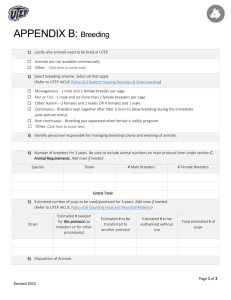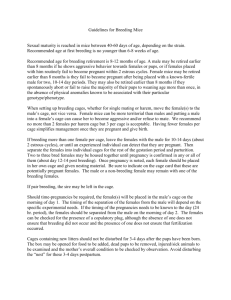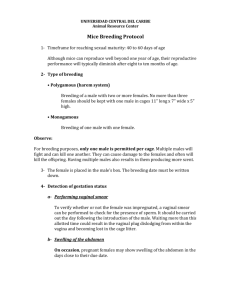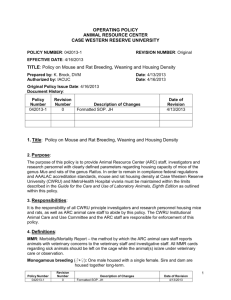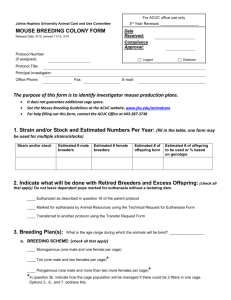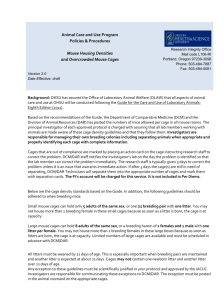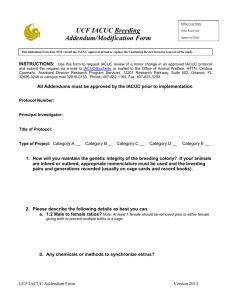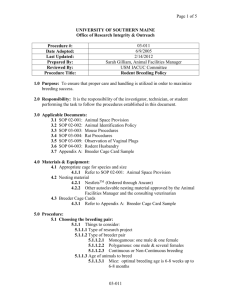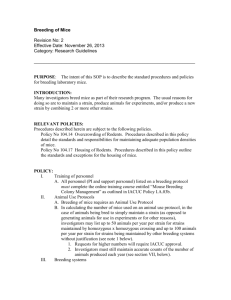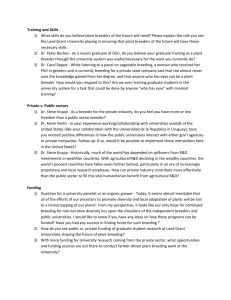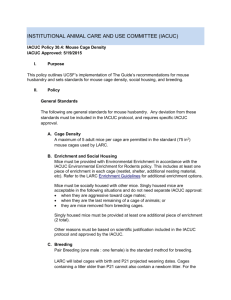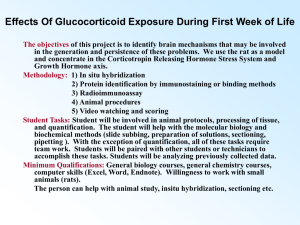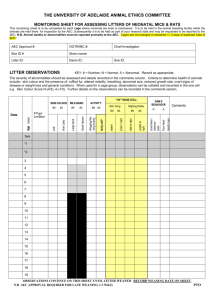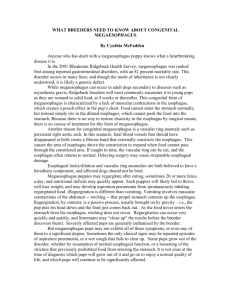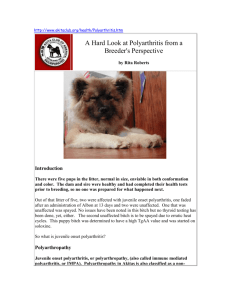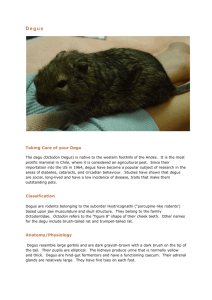Tips for Successful Breeding
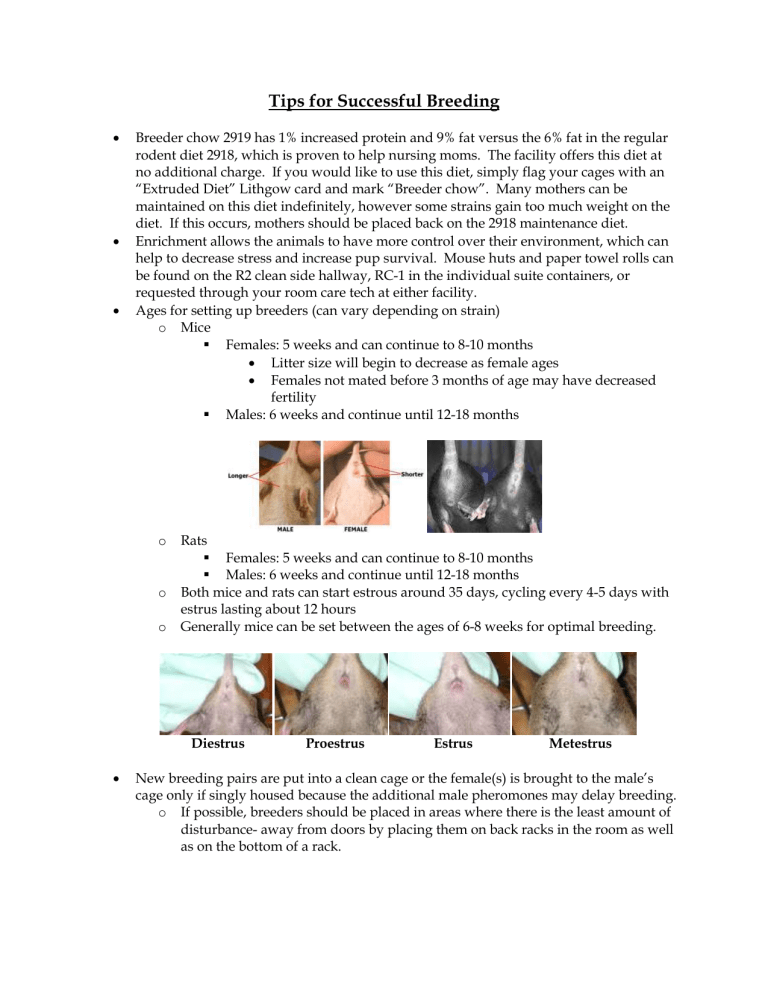
Tips for Successful Breeding
Breeder chow 2919 has 1% increased protein and 9% fat versus the 6% fat in the regular rodent diet 2918, which is proven to help nursing moms. The facility offers this diet at no additional charge. If you would like to use this diet, simply flag your cages with an
“Extruded Diet” Lithgow card and mark “Breeder chow”. Many mothers can be maintained on this diet indefinitely, however some strains gain too much weight on the diet. If this occurs, mothers should be placed back on the 2918 maintenance diet.
Enrichment allows the animals to have more control over their environment, which can help to decrease stress and increase pup survival. Mouse huts and paper towel rolls can be found on the R2 clean side hallway, RC-1 in the individual suite containers, or requested through your room care tech at either facility.
Ages for setting up breeders (can vary depending on strain) o Mice
Females: 5 weeks and can continue to 8-10 months
Litter size will begin to decrease as female ages
Females not mated before 3 months of age may have decreased fertility
Males: 6 weeks and continue until 12-18 months o Rats
Females: 5 weeks and can continue to 8-10 months
Males: 6 weeks and continue until 12-18 months o Both mice and rats can start estrous around 35 days, cycling every 4-5 days with estrus lasting about 12 hours o Generally mice can be set between the ages of 6-8 weeks for optimal breeding.
Diestrus Proestrus Estrus Metestrus
New breeding pairs are put into a clean cage or the female(s) is brought to the male’s cage only if singly housed because the additional male pheromones may delay breeding. o If possible, breeders should be placed in areas where there is the least amount of disturbance- away from doors by placing them on back racks in the room as well as on the bottom of a rack.
Continuously paired breeders (one male with one female) work well because you can take advantage of post-partum estrous where a female can become pregnant the day she gives birth to a litter: o A disadvantage is that the pups need to be weaned at 21 days because of the possibility of two litters in the cage
Can be a problem if pups run small (certain KO mice)
Triads (one male with two females) can be set, but there are some disadvantages such as: o If females are sisters that were housed together after weaning, then both females tend to get pregnant. If the females come from separate cages, then usually one female dominates over the other and won’t allow her to breed until the dominant female is separated. o Non-dominant female will usually only get pregnant once dominant female is removed. o Male starts to be flip-flopped between two cages which is not maximizing pup production because there is no utilization of the post-partum estrous.
Stress to females can cause pup death by neglect or cannibalism. Examples of stresses are: o Disturbing the cage environment by opening the cage, adding/removing enrichment, or cage furniture o Removing male right before or after pup birth o Separating females from cage right before or after pup birth o Manipulating pups- touching pups within a week of birth. If pups must be handled then always us a gloved hand and attempt to apply the mothers scent by rubbing the glove with feces/dirty bedding or if possible the mother’s urine.
Please remember that you must remain compliant with the IACUC rodent overcrowding policy. If multiple litters are in the cage, you are obligated to separate them for animal welfare reasons regardless of the risk of cannibalism or maternal neglect. Therefore, it is essential that you separate mothers prior to the litter being born.
Each facility provides a Lithgow card for mating cages. These can be found in your housing room and are labeled with “Check for Pups” and “Wean”. On the back of these cards you can track births, pups lost, and successful weaning. This will help you when determining that a female needs to be retired by indicating a decrease in her fertility
(indicated by increasing time between litters and / or decrease in average litter size).
DO NOT retire old breeding pairs until you have confirmation that your new pairs are breeding, and then retire old breeders. o Staggering your setup of breeders can help to ensure that you always have a pair producing pups. o To retire old breeders, you may end of setting new breeding pairs a month prior than planned to ensure successful breeding before ending old pairs.
Although the light cycle, temperature and humidity is often controlled in mouse housing areas, many rodent production colonies experience a drop in production during the winter months (October-March). This seasonal variation may result in smaller litter sizes, irregular estrous cycles, lower conception rates and lower wean rates.
If your colonies regularly experience this drop, you may need to set up more breeding pairs and ensure a continuous supply of younger breeders during these months to keep your colony production at appropriate levels.
Problems can be due to external factors such as: o Odor from staff working with animals (heavy perfume/cologne, cigarette smoke) o Entering the housing room after hours (8p-6a) o Volume of conversations/music in the housing room o The number of lab personal working in the room daily o Smashing cages into the rack o Inexperienced /unconfident handling of the mice
